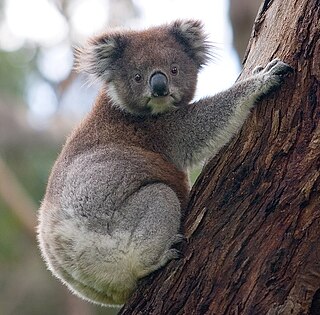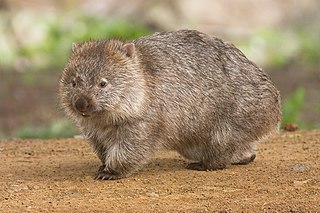 W
WThe Vombatiformes are one of the three suborders of the large marsupial order Diprotodontia. Seven of the nine known families within this suborder are extinct; only the families Phascolarctidae, with the koala, and Vombatidae, with three extant species of wombat, survive.
 W
WThe common wombat, also known as the coarse-haired wombat or bare-nosed wombat, is a marsupial, one of three extant species of wombats and the only one in the genus Vombatus. The common wombat grows to an average of 98 cm (39 in) long and a weight of 26 kg (57 lb).
 W
WThe koala or, inaccurately, koala bear is an arboreal herbivorous marsupial native to Australia. It is the only extant representative of the family Phascolarctidae and its closest living relatives are the wombats, which are members of the family Vombatidae. The koala is found in coastal areas of the mainland's eastern and southern regions, inhabiting Queensland, New South Wales, Victoria, and South Australia. It is easily recognisable by its stout, tailless body and large head with round, fluffy ears and large, spoon-shaped nose. The koala has a body length of 60–85 cm (24–33 in) and weighs 4–15 kg (9–33 lb). Fur colour ranges from silver grey to chocolate brown. Koalas from the northern populations are typically smaller and lighter in colour than their counterparts further south. These populations possibly are separate subspecies, but this is disputed.
 W
WLasiorhinus is the genus containing the two extant hairy-nosed wombats, which are found in Australia. The southern hairy-nosed wombat is found in some of the semiarid to arid regions belt from New South Wales southwest to the South Australia-Western Australia border. The IUCN categorises it as Near Threatened. Conversely, the northern hairy-nosed wombat is categorised as Critically Endangered and only survives in a 3-square-kilometre (1.2 sq mi) range within the Epping Forest National Park in Queensland, but formerly also existed in Victoria and New South Wales.
 W
WThe northern hairy-nosed wombat or yaminon is one of three extant species of wombats. It is one of the rarest land mammals in the world and is critically endangered. Its historical range extended across New South Wales, Victoria, and Queensland as recently as 100 years ago, but it is now restricted to one place, a 3-km2 range within the 32-km2 Epping Forest National Park in Queensland. In 2003, the total population consisted of 113 individuals, including only around 30 breeding females. In the last census taken in 2013, the estimated population was 196 individuals, with an additional 9 individuals at the Richard Underwood Nature Refuge at Yarran Downs near St. George in southern Queensland. In recent years, the population has experienced a slow but steady increase to an estimated 230 individuals in 2015.
 W
WThe Phascolarctidae is a family of marsupials of the order Diprotodontia, consisting of only one extant species, the koala, and six well-known fossil species, with another five less well known fossil species, and two fossil species of the genus Koobor, whose taxonomy is debatable but are placed in this group. The closest relatives of the Phascolarctidae are the wombats, which comprise the family Vombatidae.
 W
WPhascolarctos is a genus of marsupials containing only one extant species, the koala (P. cinereus). The genus was named by French zoologist Henri Marie Ducrotay de Blainville in 1816.
 W
WThe southern hairy-nosed wombat is one of three extant species of wombats. It is found in scattered areas of semiarid scrub and mallee from the eastern Nullarbor Plain to the New South Wales border area. It is the smallest of all three wombat species. The young often do not survive dry seasons. It is the state animal of South Australia.
 W
WWombats are short-legged, muscular quadrupedal marsupials that are native to Australia. They are about 1 m (40 in) in length with small, stubby tails and weigh between 20 and 35 kg. There are three extant species and they are all members of the family Vombatidae. They are adaptable and habitat tolerant, and are found in forested, mountainous, and heathland areas of southern and eastern Australia, including Tasmania, as well as an isolated patch of about 300 ha in Epping Forest National Park in central Queensland.